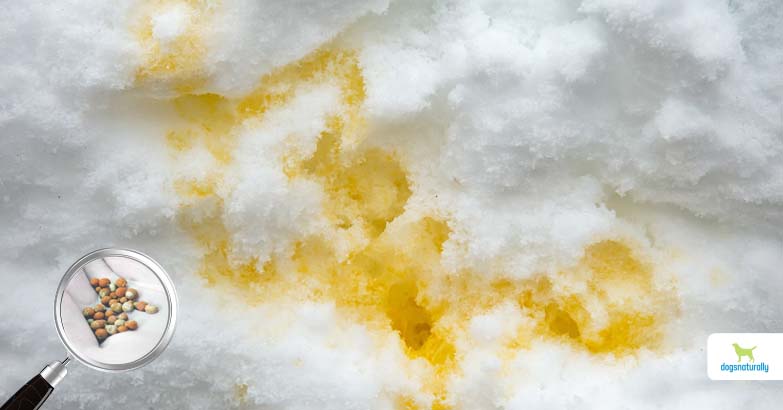Here’s a trivia question for you: What’s a urolith?
If you answered bladder stone, you’re right! Urolith is the technical term for bladder stones. The suffix “-lith” means stone. (Think of the megaliths at Stonehenge.)
Bladder stones can be very painful for your dog. And sometimes she may need surgery to remove them. But there are some new technologies that can help remove stones without surgery.
This post explains bladder stones in dogs. And we’ll tell you what you need to know about conventional veterinary treatments.
What Are Bladder Stones?
Bladder stones are just what they sound like … stones that form in your dog’s bladder. Your vet may use the term urolithiasis to describe the condition. It means stones (or uroliths) anywhere within the urinary tract. Stones can develop in the kidney, ureter, bladder, or urethra. But the bladder is most common.
Bladder stones can develop over weeks or months. They usually happen because of excess minerals in the urine. First, they form tiny crystals. But over time, the crystals irritate the bladder lining which produces mucus. The mucus and crystals can clump together, grow larger and harden into stones.
What Causes Bladder Stones In Dogs?
Several situations can lead to bladder stones …
- Bacteria in the urinary tract (urinary tract infection)
- Urinary pH
- Minerals in the urine form crystals and grow into stones
- Genetics may be a factor
- Bladder inflammation
Diet is also an important element in bladder stones and we’ll get into that later.
RELATED: Inflammation can cause more than just bladder stones …
PRO TIP
No Smoking! Exposure to cadmium increases stones. How are dogs exposed to cadmium? The most common reason is cigarette smoke. So no smoking around your dog (for lots of reasons!).
Types Of Bladder Stones In Dogs
There are several types of bladder stones. The most common ones are:
Struvite Stones
Struvite stones form due to excess magnesium, ammonium and phosphorus. Dietary magnesium can be a factor.
Struvite crystals alone don’t mean your dog will get struvite stones. However, they’re more likely when your dog has a bacterial infection. Stones can develop from certain bacterial UTIs, especially from Staphylococcusor proteus bacteria.
Struvite stones form in high pH (alkaline) urine. Most struvite stones in dogs are in females.
Calcium Oxalate Stones
Calcium oxalate stones can form from too much calcium in the urine. It’s called hypercalciuria. Several things can cause hypercalciuria, including …
- Overabsorption of calcium causing more calcium in urine (absorptive hypercalciuria)
- Kidneys releasing too much calcium (renal leak hypercalciuria)
- Excess mineral loss from bones into blood stream (resorptive hypercalciuria)
(This last one is less common. One study found that resorptive hypercalciuria did not increase bladder stone risk.)
Calcium oxalate stones like a more acidic (low pH) environment.
The Curious History Of Struvite Vs Calcium Oxalate Stones
It’s interesting to note the frequency of struvite and calcium oxalate stones.
There used to be more struvite stones. But vets treated them with prescription diets that acidified the urine. So then calcium oxalate stones became more common. Prescription diets changed again to increase pH.
So now struvite stones are more common again.
RELATED: Why you should avoid prescription diets for dogs …
Urate Stones
Urate stones are much less common. Except in Dalmatians. The breed has a genetic problem that prevents them from metabolizing substances called purines. Purines convert to uric acid. In humans, this can cause gout … but in Dalmatians it can lead to urate stones. Low purine diets can help this condition (we’ll talk about that later).
Dogs with liver (portosystemic) shunts can also get urate stones. This is a condition usually seen in small dogs. Abnormal blood vessels bypass the liver … connecting the digestive tract directly to the circulatory system.
Other Stones
Rarer types of stones include cystine and silica. These thrive in acidic environments. Calcium phosphate stones form in alkaline environments. These types of stones are much less common (about 2% of cases). They’re often genetically linked to specific breeds.
Breeds Prone To Bladder Stones
There’s been quite a bit of research into the dogs most affected by bladder stones.
One 10-year Canadian study looked at more than 40,000 dogs with bladder stones. More than 85% of cases were struvite and calcium oxalate stones. Struvite were more common in females and calcium oxalate in males.
Any dogs can get bladder stones, but breeds most affected are …
- Shih Tzu
- Miniature Schnauzer
- Bichon Frise
- Lhasa Apso
- Yorkshire Terrier
- Dalmatians (Urate stones)
- Newfoundlands (Cystine stones)
- German Shepherds (Silica stones)
Symptoms Of Bladder Stones In Dogs
Stones often don’t cause a problem until they’re larger or there are enough of them to affect urination. Your dog might have bladder stones if you see some of these symptoms:
- Difficulty peeing – straining, frequent attempts*
- Pain when peeing
- Urine leakage or odor
- Urine odor
- Incontinence, peeing indoors
- Blood or pus in urine
- Lethargy
- Reduced appetite
- Licking the urinary opening
- Abdominal pain
- Recurring UTIs
*Important: Complete urinary obstruction is a life-threatening emergency. So if your dog can’t pee at all, get to your vet quickly. He may show signs of pain when trying to urinate too. Urinary obstruction can be fatal in 24-48 hours.
Many of the above symptoms are signs of a urinary tract infection as well. And sometimes UTIs can lead to bladder stones. So if you treat your dog for a UTI that doesn’t resolve, consult your vet.
Some dogs may not even show symptoms of bladder stones. In that case you may find out about them at a routine vet visit, or if they show up on x-rays done for another reason.
How Are Bladder Stones In Dogs Diagnosed?
In some cases, your vet may be able to palpate the bladder and feel the stones. If your dog has a urinary blockage, your vet should palpate very cautiously. Otherwise there’s a risk of rupturing the bladder.
But usually they’ll want to confirm a bladder stone diagnosis with x-rays. Some types of mineral stones aren’t visible on x-rays. So your vet may use ultrasound or a they’ll do a contrast x-ray with dye.
Your vet will also want to find out which type of stone it is. Treatment is different for different types of stones. Removing stones for testing is the only way to be certain. But other factors can help your vet figure out which kind of stone it is …
- Type of any crystals in the urine
- Whether stones can be seen on x-rays
- Urinary pH
- Your dog’s sex, age and breed
- If there is bacterial infection
Your vet may also check blood work for any unusual results.
Can Dogs Pass Bladder Stones?
Female dogs may pass some smaller stones when they pee. But it’s difficult in males. Females have a shorter urethra with a wider diameter.
If you see your dog straining and then suddenly peeing a lot, he or she may have just passed a stone. If you can find it, take it to your vet for analysis.
But in males, the stones can pass into the urethra and can get stuck on their way through the penis. Your dog’s pee will be reduced to a dribble if this happens. Or it could cause a total blockage. While this is unusual, it’s a potentially fatal emergency, so get your dog to the vet fast if he can’t pee.
Conventional Treatments For Bladder Stones In Dogs
Conventional vets have several different approaches. The options depend on the type of stone and severity of your dog’s condition. Some procedures may not be offered at all clinics due to the need for specialized equipment.
- Changing diet to dissolve the stones (“dietary dissolution”)
- Ultrasonic dissolution
- Urohydropropulsion
- Cystoscopic guided removal
- Laser lithotripsy
- Surgical removal (different types)
Here are the treatments your vet may propose. They’re ranked from least (1) to most (6) invasive … with surgery as the final option.
1. Dissolve Stones With Diet
The approach will depend on which type of stones your dog has and where they are.
The disadvantage to dietary dissolution is that it can take a long time to dissolve the stones. Meanwhile your dog may still have uncomfortable symptoms, including recurring UTIs. And males especially can still be at risk for a urinary blockage.
Diet To Dissolve Struvite Stones
Struvite stones often stem from urinary tract infections. So the first step is to treat the infection. Conventional vets will likely prescribe antibiotics. But you can avoid them (and should) using natural remedies.
RELATED: Cranberries can help prevent UTIs …
Struvite stones can dissolve with an adjustment to your dog’s diet. You need foods that promote more acidic urine (pH <6).
Your vet will likely recommend a low protein, prescription diet. But you should avoid these diets because …
- They’re extremely low in protein.
- They’re very acidic.
- High starch diets are high in magnesium, contributing to struvite stone formation.
- They’re highly processed and offer poor quality nutrition.
- They’re usually not complete and balanced.
- High carbohydrate diets are inflammatory.
So these diets can actually worsen your dog’s health. Instead, feed your dog a home-made diet that creates more acidity in your dog.
RELATED: What to feed your dog for bladder stones …
Dissolving bladder stones with diet can take 8 to 12 weeks and sometimes as long as 20 weeks. It’s a good idea to repeat x-rays at 8 weeks to see if the stones are getting smaller. If not, they may not be struvite stones.
Diet To Prevent Oxalate Stones
Oxalate stones form in acidic environments. But conventional vets don’t usually recommend using diet to dissolve oxalate stones.
However, they do suggest using diet to prevent oxalate stones. But they recommend low protein, low oxalate diets. Holistic vets do suggest low oxalate foods.
Prevent Urate Stones In Dalmatians
Dalmatians are prone to urate stones. They need a low purine diet, covered in Home Remedies For Bladder Stones In Dogs.
Low purine diets can be effective to dissolve stones when pH is at a more alkaline level (>7).
Other Stone Removal Options
Again, dissolving stones with diet can take several weeks. So many owners opt for faster approaches to bladder stone removal.
Note: We’re providing estimated costs for the treatments below. These are just general guidelines. The estimates are just for the specific procedures. They don’t include additional costs for the vet visit, diagnosis, or follow-up. Longer hospitalization times will obviously cost more as well. And of course, some vets will charge more, especially those with “big city prices.” So always ask your vet for their cost estimate.
2. Ultrasonic Dissolution
This procedure uses high frequency ultrasound waves to dissolve stones. They break up the stones into tiny particles. The fragments can then be passed or flushed out of the bladder more easily.
Your dog shouldn’t need to be anesthetized for the process. So this is a very good option if you want to avoid putting your dog under.
But unfortunately this option isn’t widely available. (And so neither is any information about the cost!)
So be sure to ask your vet if they know any local clinics offering this procedure.
3. Urohydropropulsion
This is a non-surgical approach that can help your dog expel small bladder stones. It involves inserting a catheter into the bladder to flush stones out with saline. Any vet should be able to do urohydropropulsion.
This procedure usually requires your dog to be anesthetized … or at least heavily sedated. But it’s for a shorter period than surgical options.
Risks are low as long as the stones are all removed. However, 25% of the time stones are left in and may need follow-up surgery. There is some risk of UTI after the procedure, and bladder rupture is a possibility. There may be some blood in your dog’s urine for a few hours after the procedure.
Cost estimates for this procedure are $200 to $750.
4. Cystoscopic Guided Removal
This is a minimally invasive technique used only for small stones. But it does require anesthesia.
Your vet may use it to extract a stone for analysis before proposing treatment options.
A video camera guides the procedure. Your vet inserts a “basket” through the external urethral opening. The basket grabs and removes the stones.
Complications from this procedure are usually short term. They can include urethral swelling or blood in urine. Most dogs can go home the same day.
This procedure is less expensive than others. Anesthesia and the procedure costs range from $300 to $600. But there will be other charges for the vet visit and possible hospital stay.
5. Laser Lithotripsy
Laser lithotripsy should only be done by a specialist experienced in the procedure. It’s less invasive than full surgical options. But your dog will need to be fully anesthetized. Here’s the process.
A cystoscope is inserted into the urethra. A laser is then used to break up the stones.
Stone fragments are removed manually, or washed out with urohydropropulsion.
Your dog may need to be hospitalized overnight for observation.
This is less risky than surgery. And it’s more effective in female than male dogs. But even males have 80% success rates.
The cost varies depending on the size of dog and number of stones. Estimates range from $1300 to $2800.
Complications are unusual, but there is some risk of injury from the cystoscope or laser. There could be some swelling in the urethra that causes obstruction. And of course, there are always risks with any anesthesia.
6. Percutaneous Cystolithotomy (PCCL)
PCCL requires an incision and full anesthesia. But it’s still an outpatient procedure. It requires specialized equipment that may not always be available locally.
A small (1-2 cm) incision is made in the abdomen. The stones are then retrieved using video guidance.
One study found that PCCL works well for any size dog and any number of stones. There were fewer complications than with surgical removal. Hospital stays were usually shorter, with most animals going home the same day.
The procedure takes longer than surgical removal via open cystotomy (see below). It’s about $750 more expensive.
7. Surgery For Bladder Stones In Dogs
Surgical removal is often the fastest way to remove bladder stones. And if your dog has a urinary obstruction or severe case of stones, it’s an emergency surgery that’s unavoidable and life-saving.
Veterinary homeopath Dr Dee Blanco told me that many owners opt for surgery as the quickest way to relieve their dog’s discomfort. Especially because dissolution using diet and natural remedies can be slow.
Dr Blanco said “The stones are usually are so bad they need surgery. Especially when the vet shows the owner the x-rays – people just march to surgery!”
Surgical removal is called cystotomy. It can be done via “open cystotomy” or “laparoscopic cystotomy.”
Laparoscopic Vs Open Cystotomy
Comparing the two procedures, one study found laparoscopy …
- Is less invasive
- Is as effective as open cystotomy at removing stones
- Takes about 50 minutes longer than open cystotomy
- Is a more expensive surgery
- Requires less pain medication
Hospitalization time and related cost is similar for both procedures. Another study found that laparoscopy posed less risk of surgical site infection.
The cost of open cystotomy surgery is estimated at $800 to $1400. Laparoscopic cystotomy is usually at least $300 more.
Can You Use Natural Remedies for Bladder Stones In Dogs?
This post explains bladder stones in dogs and treatments your vet may recommend.
But there are several natural approaches to bladder stones covered in a separate post. Some may ease your dog’s symptoms. Others may help bladder stones dissolve or pass. But all these natural remedies will take longer than the conventional methods.
RELATED: Home remedies for bladder stones in dogs …
Bladder stones can be painful and even life-threatening. So sometimes you might need to resort to conventional procedures.
Making Decisions
It’s a great idea to consult a holistic vet as well as a conventional one. Then you’ll know all the options. The severity of your dog’s condition will help determine how fast stones need to be removed.
References
Lulich JPet al. ACVIM small animal consensus recommendations on the treatment and prevention of uroliths in dogs and cats. J Vet Intern Med. 2016;30(5):1564-1574.
Houston DM, Moore AE. Canine and feline urolithiasis: examination of over 50 000 urolith submissions to the Canadian veterinary urolith centre from 1998 to 2008. Can Vet J. 2009 Dec;50(12):1263-8.
Austin C. Luskin et al. Bone resorption in dogs with calcium oxalate urolithiasis and idiopathic hypercalciuria. Research in Veterinary Science. 2019;123:129-134.
Ling GV et al. Urolithiasis in dogs. II: Breed prevalence, and interrelations of breed, sex, age, and mineral composition. Am J Vet Res. 1998 May;59(5):630-42.
Arulpragasam SP et al. Evaluation of costs and time required for laparoscopic-assisted versus open cystotomy for urinary cystolith removal in dogs: 43 cases (2009-2012). J Am Vet Med Assoc. 2013 Sep 1;243(5):703-8.
Espinel, Jorge et al (2019). Incidence of surgical site infection in dogs undergoing soft tissue surgery: risk factors and economic impact. Veterinary Record Open. 6(1):e000233.
Bevan JM et al. Comparison of laser lithotripsy and cystotomy for the management of dogs with urolithiasis. J Am Vet Med Assoc. 2009 May 15;234(10):1286-94.
Cléroux A. Minimally Invasive Management of Uroliths in Cats and Dogs. Vet Clin North Am Small Anim Pract. 2018 Sep;48(5):875-889.
Lulich JP et al. Changing paradigms in the treatment of uroliths by lithotripsy. Vet Clin North Am Small Anim Pract. 2009 Jan;39(1):143-60.
Lulich JP et al. Nonsurgical removal of urocystoliths in dogs and cats by voiding urohydropropulsion. J Am Vet Med Assoc. 1993 Sep 1;203(5):660-3.
Langston C et al. Methods of urolith removal. Compend Contin Educ Vet. 2010 Jun;32(6):E1-7;quiz E8.
Cruciani B et al. Removal of lower urinary tract stones by percutaneous cystolithotomy: 68 cases (2012-2017). Vet Surg. 2020 Jun;49 Suppl 1:O138-O147. doi: 10.1111/vsu.13398.














